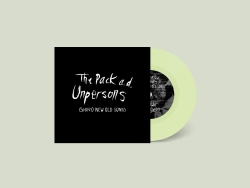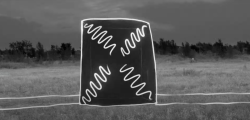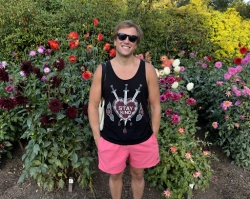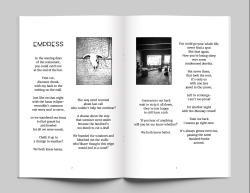Cassia Hardy's record In Relation is out on May 23! Here's an essay from the accompanying zine written by Rylan Kafara about the gentrification processes in Edmonton.
Over the last twelve years, the land in downtown amiskwaciy (Edmonton) has seemingly transformed. This transformation is but the most recent iteration of a far broader process of settler colonialism. It was spurred by a major professional sports and entertainment development: Rogers Place arena, the $613.7 million dollar publicly-financed home of the Edmonton Oilers ice hockey franchise. Before the Oilers moved downtown and the area was renamed “Ice District” by the team’s owner, the Katz Group, this place was already home to many thriving and diverse human and non-human residents.
These residents were displaced through gentrification. The processes of gentrification reshape land and property. The land and property are bought cheaply and turned into profitable spaces of capital accumulation. In downtown amiskwaciy, this transformation began as soon as the arena deal was signed between the City of Edmonton and the Katz Group in 2013. Land and property owners were prepared for the deal. The Mayor at the time, a developer himself, used the arena as a catalyst to build skyscrapers like the Edmonton Tower and Stantec Tower, and move the museum, upscale businesses, amenities, condos, and people from other parts of the city to downtown. That Mayor then handed the keys to the city to the next Mayor, who was taught that boosting the deal would help his career. This continued a cycle that began during the settlement of Edmonton.
Civic-corporate partnerships are the crux of this cycle. They are beneficial for company profit margins, property owners, and political careerists, but they are rooted in transactional relationships of extraction and destruction.
In these types of relationships, public resources are funneled to private coffers. In the case of Rogers Place, the City of Edmonton took out a loan to build the arena, while every cent of revenue goes to the Katz Group for 35 years. By the time the City pays off the debt-financing of Rogers Place, it will likely be time to build a new home for the Edmonton Oilers. This is a cycle of planned facility obsolescence that is strategically employed by professional sport franchise owners across the continent. The City also gave the Katz Group the contract to build the Edmonton Tower, which houses City employees in return for the City paying increasing rates of premium rent in perpetuity. The Katz Group quickly sold the Edmonton Tower to an investment fund company in 2018, and then sold part of the Stantec Tower to a German real estate fund company in 2019 for over $500 million.
These transactional relationships also demolish. The spaces used by pre-existing residents to rest, visit, and move around downtown were removed and paved over. The local Greyhound Bus Station shut down. The adjoining A&W coffee shop closed too. An art collective had its rent hiked until it had to disband. The cascading effects went on and on as creative and comfortable spaces were removed to help perpetuate further extraction. Non-human life was also erased. A nearby community garden tended to by unhoused residents had its lease terminated. The garden was evicted and the land was turned into a gravel parking lot. Where the arena now sits, birds had swam in pools of rain water. These pools were covered by concrete, laid across from an apartment building called the MacDonald Lofts. That building now sits empty.
When Rogers Place opened, the Katz Group bought the MacDonald Lofts. The Lofts had housed those most ill-served by the housing industry. The Katz Group evicted the residents of the Lofts, and many were once again houseless, or subsequently passed away. Some of the Lofts’ residents later lived at Pekiwewin (Nêhiyawak/Cree for the act of coming home, an Indigenous-led encampment near the northern bank of the kisiskâciwanisîpiy (Nêhiyawak/Cree for swift flowing river). The kisiskâciwanisîpiy was also where racial capitalism first arrived with the fur trade, and Fort Edmonton was built in amiskwaciy in 1795. But Indigenous Peoples had been meeting, trading, and conducting ceremony on the bank of the kisiskâciwanisîpiy for far, far longer. In 2020, roughly 400 people lived at Pekiwewin from July-November. Before the police eviction of Pekiwewin, encampment residents, volunteers, and organizers participated in reciprocal, life-sustaining practices. These practices offered ways of living concurrent to the extractive and destructive conditions and confines of racial capitalism, and its ongoing modus operandi in Edmonton, settler colonialism.
The recent story of Rogers Place and the Ice District development is but one example of life within the confines and conditions of racial capitalism in the settler colonial context. Capitalism can be more articulately understood as racial capitalism because it needs racial inequity to function. Since its beginnings during the Industrial Revolution, capitalism worked hand in hand with imperialism and slavery. Settler colonialism continues this inequity through an iterative process of settling and resettling territory through Indigenous dispossession, displacement, and erasure. Settlement began en masse in Edmonton in the 1870s. At that time, developers and land speculators stole land from the Papaschase, Métis, and other Indigenous Peoples.
Settler colonialism and its processes of gentrification continue this iterative process today. The process occurs through large-scale developments such as Rogers Place, and smaller-scale instances of rent increases—unrestrained by rent control or other protective measures—and evictions. Gentrification is then sustained by the settler-state and its institutions—such as the police—by enshrining the removal of houseless Edmontonians, the majority of whom are Indigenous, from public spaces in both settler law and through practices like fines, arrests, and encampment clearings.
Racial capitalism has only existed for a handful of centuries and for an even shorter amount of time in amiskwaciy. Gentrification has existed for less than a century. It’s only decades old. After oil was first extracted from beneath the surface of land near amiskwaciy in 1947, Alberta’s first oil boom began. This coincided with the worldwide “white flight” from urban cores in the 1950s, with wealthier white residents moving to the suburbs, leaving less affluent, largely racialized residents living downtown. On the prairies, this happened in tandem with the end of the pass system, which limited Indigenous Peoples’ mobility outside reserves from the 1880s to the 1940s. When the pass system ended, Indigenous Peoples began moving to downtown amiskwaciy, joining vibrant Black and Chinatown communities. These racialized communities were the focus of downtown gentrification schemes beginning in 1950. That year, boosters for a large-scale development called “the Miracle Mile” promised to bring wealthier white residents back downtown to visit what would have been the city’s first shopping mall. That development failed a public vote, and so did a project called the Omniplex in 1970, a futuristic development that planned to house both a football field and hockey rink, thanks to a moveable floor.
The failure of the Miracle Mile and the Omniplex taught civic boosters important political lessons. Shortly after the failure of the Omniplex, Northlands Coliseum and Commonwealth Stadium were approved and built with public money, and the latter resulted in the displacement of an entire neighborhood of ethnically diverse and working-class people ahead of the 1978 Commonwealth Games. In the 1980s and 1990s, the downtown community was thriving, but confined, policed, and surveilled in a series of working-class pubs, hotels, and taverns. During a gentrification wave called the Quarters Revitalization beginning in the mid-2000s, all of these community hubs were demolished, renovated, or renovicted to serve more upscale tenants or cliental.
Gentrification processes, from small to large scale, dispossess and displace pre-existing residents from their homes. Such negative impacts were detailed in Edmonton city planner reports from at least the mid-1960s. Even so, the processes knowingly continue in city planning today. In 2013, the social agency across from where Rogers Place was built, Boyle Street Community Services, bought its building in secret. Boyle Street’s leadership at the time knew the City’s plan for the agency, and its unhoused clients, was for them “to disappear”. Eventually, the Katz Group did purchase Boyle Street’s building, and evicted the agency on Truth and Reconciliation Day, September 30, 2023. In the following days, at least 120 unhoused residents—the majority of whom are Indigenous—died in the aftermath of Boyle Street’s eviction.
Currently, rent increases continue unabated. The number of houseless amiskwaciy residents has roughly doubled in the past year. A punitive public spaces bylaw aiming to restrict the movement of houseless residents—and thereby their life-sustaining relationships—goes into effect on May 12, 2025. And Edmonton’s city-council, that unanimously passed the bylaw, is set to approve giving hundreds of millions more in public funding to the Katz Group’s developments in Ice District.
There are glimmers of hope, however, as shown at Pekiwewin. And by the myriad, everyday ways people care and support each other in navigating gentrification and its harms. Gentrification tries to fracture life-sustaining relationships, but it does not end these relationships between people, non-human life, and land. These connections and reciprocal relationships have existed much longer than racial capitalism, settler colonialism, and gentrification. And these life-sustaining relationships will still be here in amiskwaciy far after racial capitalism leaves the banks of the kisiskâciwanisîpiy.
--
Rylan Kafara (he/him) is a settler researcher, educator, and community helper. He holds a BA and MA in history, and is finishing a PhD at the University of Alberta. Rylan currently teaches sociology and history, and his research focuses on how forms of creativity, recreation, and community support are used by unhoused Edmontonians to both navigate the challenges of houselessness and enrich their lives. Rylan was a city-centre harm-reduction worker for nearly a decade, and volunteers with numerous community initiatives. He also co-hosts a weekly radio show called The History of Punk, and a podcast on houseless encampments called Keep Moving on CJSR 88.5FM. Rylan is grateful for all the life-sustaining relationships he has in the beautiful beaver hills.
Find Rylan’s current projects and research at www.citycentreedmonton.com and please contact him with any questions, ideas, or thoughts at rkafara@ualberta.ca.









